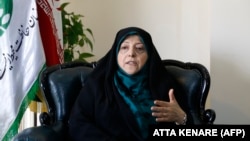Iran’s vice president and head of the Environmental Protection Organization, Massoumeh Ebtekar has warned of the deteriorating condition of some of the country’s wetlands to “dangerous” levels because of Turkish dams.
“Excessive construction of dams in Turkey has plunged Hoor al-Azim wetlands into a dangerous condition,” he said on June 16.
Ebtekar called on the Iranian Foreign Ministry to step in and save the wetlands from desiccation through talks with Ankara.
Meanwhile, Ebtekar also blamed the desiccation of Iraq’s wetlands and the reduction of its river’s water level for jeopardizing Hoor al-Azeem.
Furthermore, some 5,000 Iranians have signed a petition sent to UN Secretary-General Antonio Guterres calling on Turkey to stop constructing dams that lead to desiccation of the Euphrates and Tigris rivers in Iraq and consequently the drying up of the Hoor al-Azim wetlands in southwestern Iran.
The petition says Turkey “has constructed a tremendous number of dams in the Southern Anatolian region and the headwaters of the Tigris and Euphrates rivers,” Fars News Agency reported.
The wetlands, expanded in the lower parts of the Euphrates and Tigris, are situated along the Iran-Iraq border and play a vital role in keeping the environmental balance in the region.
The Tigris runs from Lake Hazar in the Taurus Mountains in Turkey, joining the Euphrates and passing through Iraq before finally flowing as the Shat al Arab into the Persian Gulf.
“Talking to Turkey about the catastrophic situation of Hoor al-Azim is the main responsibility and duty of Iran’s Foreign Ministry,’ Ebtekar said. “The Environmental Protection Organization has done its utmost to save the wetlands from desiccation and now the ball is in the ministry’s court.”
Hoor al-Azim is said to be the largest source of dust particle storms in Khuzestan.
Last January, the oil-rich province of Khuzestan was battered by intense dust storms that disrupted flights and even canceled Friday Prayers. The dust (microparticle) storms, at a speed of 66 km/hour, pushed people of Ahvaz, Khuzestan’s capital, to the verge of suffocation. It was almost impossible for people of Ahvaz to risk leaving their homes without proper masks.
However, compared with 2013, Hoor al-Azim is in a “much better condition,” claimed Ebtekar, while reporting that some parts of the Hoors in Iraq has even been rehydrated.
Hoor al-Azim, which is also called Hoor al- Hoveyzeh or Hovayzeh’s great wetlands, is the largest of its kind in Khuzestan and one of the largest marshlands in Iran.
In an interview with Iran Labor News Agency, Ebtekar admitted that Iran’s Oil Ministry, by constructing dams, had also played a role in Hoor’s desiccation but, following some consultations in 2015, the problem has been resolved.
One of the environmental promises of Hassan Rouhani’s first term as president was the revival of Hoor al-Azim. According to Ebtekar, 80 percent of the wetlands is now refilled.
Ebtekar has always accused Rouhani’s adversaries as the main perpetrators in spreading “negative news” concerning the Hoor.
“It is imperative to know whether the negative news perpetrated by some with ulterior motives to create an anti-government atmosphere is true or false,” he said.
However, even Rouhani’s officials have always admitted that outdated oil drilling and exploration methods over past years are to blame for the wetland’s desiccation.





